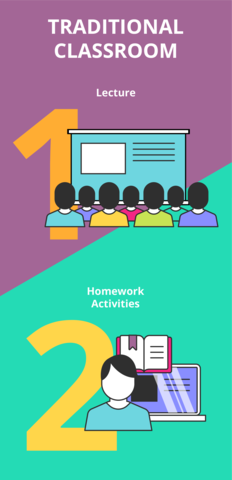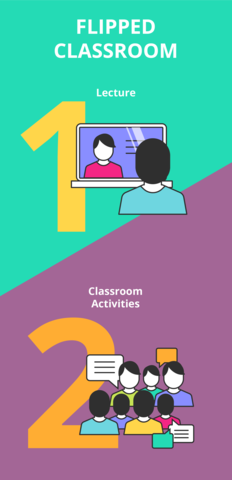Innovative Teaching Strategies That Improve Student Engagement
When it comes to higher education, recent findings have proven that student engagement is the most effective means of learning – outperforming lectures – but is still the least applied teaching strategy. A study of over 2,000 university classes in science, technology, engineering, and math (STEM), where nearly 550 faculty were observed while teaching over 700 courses at 25 institutions across America and Canada, found that 55 per cent were still using conventional lecture techniques to teach – a style that is proven to be the least effective at teaching and engaging students.1 A mere 18 per cent displayed a student-centred style of teaching with a focus on group work and discussions.
Research has showed that student engagement strategies improve students’ learning and attitudes toward learning.2 Student engagement has long been recognised as a key element in student learning and achievement,3 and was identified by the American National Research Council, as far back as 2003, as a critical goal of national school improvement efforts.4
What is student engagement?
The National Study of Student Engagement (NSSE), an annual analysis of student engagement in universities in America, measures and defines it as follows:5 Student engagement represents two critical features of collegiate quality: how much time and effort students put into their studies and other educationally motivated activities; and how the educational institution deploys its resources and organises the curriculum and other learning opportunities in order for students to participate in activities that are linked to student learning.
Student engagement also refers to the degree of attention, curiosity, involvement, optimism, and passion that students display while being taught, which improves how much they learn and retain, as well as their persistence and enjoyment in completing work.6
If student engagement is proven to be the more effective teaching strategy, then why is it adopted so poorly? One potential reason highlighted by a Nebraska study is a lack of training for faculty in the skills needed to utilise the innovative strategies that improve student engagement, such as smaller class sizes, open classroom layouts, and other strategies that minimise the reliance on conventional lecturing.7
Innovative teaching strategies that improve student engagement
- Inquiry-based learning.8 Inquiry-based learning is a powerful strategy that triggers student curiosity. This allows students to formulate their own understanding based on research and questions. Students also get an opportunity to present what they have learnt to the group, and can reflect on what was successful and what needed more attention. Teachers act as facilitators and answer questions posed by the students as they work towards finding answers through research and independent discovery.
- Flipping the classroom.9 In this strategy, class time is inverted to traditional lectures and fosters inquiry, application, and assessment to better engage individual learners and their needs. Students study material outside of class by reading, watching short pre-recorded video lectures, or researching assignments. Class time is used to help students work through the material in groups, or individually, for active learning, with an emphasis on higher-order thinking and application to complex problems.


Common innovative activities include:
-
- Working in groups to find solutions
- Working through case-studies to learn
- Peer instruction
- QR codes.10 QR (Quick Response) codes allow students to access information or interact with lectures by scanning the code with their mobile phones or digital devices. QR codes are easy to create and have multiple applications, such as:
- Checking answers
- Voting during class discussions
- Supplementing textbook information
- Getting survey data
- Accessing video tutorials
- Sharing their learnings with peers
- Personalised learning.11 Personalised learning covers everything from the choice of institution to method and mode of learning. Learning can be tailor-made to suit the individual. These include:
- Blended learning.12 This teaching strategy places more responsibility on the student, with less direct instruction from the teacher and more discovery-based methods of learning from the student. It allows students to decide where and at what pace they work through the material
- Adaptive learning.13 Adaptive learning technology gathers data about student behaviour as they answer questions and uses that data to give instant feedback so that the learning can be adjusted accordingly
- Project-based learning (PBL).14 Develops deeper learning competencies that the student can use throughout their studies and careers. PBL engages students by using real-world challenges, problems, and scenarios to evoke critical thinking, problem-solving, collaboration, and self-management. The students then present their solutions to the group and class. PBL is an effective teaching strategy in that it engages students, improves learning, and makes students more aware of real-world issues.
- Technology.15 There is a delicate balance with the use of technology in the classroom, and teachers should use it wisely to foster student engagement. Student engagement and collaboration can be supported by websites and apps, such as Google Docs, YouTube, and the Remind app.16 Technology allows teachers to engage with their students, remind them about upcoming assignments, supplement learning through online videos, and encourage student collaboration.
- Jigsaws.17 A tried-and-trusted cooperative learning technique that allows students to create their own learning. Students are divided into groups and each group is given different pieces of information that they have to learn sufficiently to teach to another group. This allows students to become experts in what they have learnt as they teach others. When every group has learnt their information, they are arranged into new groups, made up of a member of each of the small groups, like a jigsaw of different information pieces coming together into each new group. Every member then shares what they have learnt, bringing the lessons to life, and enabling students to create their own learning by engaging with one another and the material.
- Studying.18 While this may seem like an outdated strategy for student engagement, studying is also a form of student engagement and is linked to educational progress and success. Serious reading outside of classrooms improves the understanding of factual and fictional concepts, and intentional writing increases students’ ability to think clearly. In a recent survey of universities in America, 76 per cent of faculty estimated that students spend five hours or less weekly to prepare for the courses they taught, with only 30 per cent believing that the average student completes ‘most’ or ‘all’ of the assigned reading.19 Adequate learning hinges not only on engaging techniques but also on students’ willingness to allocate enough time outside of class to focus on the study of academic material.
Each of the teaching strategies listed above enable students to learn by solving problems, discovering solutions, and developing critical thinking. Student engagement is facilitated through strategies that move away from the traditional lecture-based approach, but rather encourage questions in class, make place for student-led research and presentation, are supported by technology, and include self-study. All of these encourage curiosity, interest, motivation, attention, and collaboration among students, and are proven to improve greater achievement in education and success in later life.
- 1 (Mar, 2018). ‘Lesson learned? Massive study finds lectures still dominate STEM education’. Retrieved from Nebraska Today.
- 2 Konold, T. Et al. (Nov, 2018). ‘School climate, student engagement, and academic achievement: a latent variable, multilevel multi-informant examination’. Retrieved from Sage Journals.
- 3 Lawson, M. Et al. (Feb, 2015). ‘Analyzing profiles, predictors, and consequences of student engagement dispositions’. Retrieved from Science Direct.
- 4 (2004). ‘Engaging schools’. Retrieved from the National Academies of Sciences, Engineering, Medicine.
- 5 (2018). ‘Engagement insights’. Retrieved from NSSE.
- 6 Palmer, B. (Aug, 2017). ‘Teacher passion as a teaching tool’. Retrieved from School of Graduate Studies.
- 7 (Mar, 2018). ‘Lesson learned? Massive study finds lectures still dominate STEM education’. Retrieved from Nebraska Today.
- 8 Davis, J. (Nov, 2017). ‘Innovative teaching strategies that improve student engagement’. Retrieved from AMLE.
- 9 (Nd). ‘Flipping the classroom’. Retrieved from University of Washington. Accessed 18 June 2019.
- 10 Davis, J. (Nov, 2017). ‘Innovative teaching strategies that improve student engagement’. Retrieved from AMLE.
- 11 Newman, D. (Jul, 2017). ‘Top 6 digital transformation trends in education’. Retrieved from Forbes.
- 12 West, P. (Mar, 2017). ‘Blended learning is at a tipping point’. Retrieved from eSchool News.
- 13 Newman, D. (Jul, 2017). ‘Top 6 digital transformation trends in education’. Retrieved from Forbes.
- 14 (Nd). ‘PBL is making headway in higher education’. Retrieved from PBL Works. Accessed 18 June 2019.
- 15 Davis, J. (Nov, 2017). ‘Innovative teaching strategies that improve student engagement’. Retrieved from AMLE.
- 16 (Nd). ‘Remind’. Retrieved from Remind. Accessed 18 June 2019.
- 17 (Nd). ‘Jigsaw technique’. Retrieved from Institute for Teaching and Learning Innovation. Accessed 18 June 2019.
- 18 Nietzel, M. (Jan, 2019). ‘A best practice for student engagement: it’s called studying’. Retrieved from Forbes.
- 19 (2018). ‘FSSE 2018 frequency’. Retrieved from FSSE.
